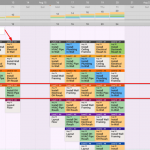If you are using the Last Planner® System you already know that the first step of implementation is to create a high-level master schedule identifying your project milestones. A successful Lean build begins with a strong master schedule and smart use of milestones. It sounds relatively simple, but what should your team be thinking about during the master scheduling session? What makes a good milestone? Let’s tackle each of these questions in turn and help your team create a strong and effective master schedule.
Master Schedule
The goal of the master scheduling session is to get a high-level view of the project, and lay the foundation for the project’s schedule. You want to make sure that in this meeting you have addressed the feasibility of the project, highlighted the long lead items, clearly identified the necessary phases, and established a team-wide understanding of the project deliverables. Milestones are an important tool in accomplishing all of these things.
What Makes a Good Milestone?
Milestones should occur at the completion of key tasks and activities. When looking to identify milestones you should look to the significance of the mark, as well as its impact on the project, and the value of completion. In addition to selecting events that have high significance, impact and value on the project, there are five other things that you should be thinking about when setting milestones.
- Amount—It is important that your project has the right amount of milestones. It is a mistake to have either too many, or too few. If there are not enough milestones your project can become delayed because of a lack of accountability. If you have too many milestones they can lose their importance in the eyes of workers.
- Timing—Milestones should be spread out evenly over the life of your project. In the same vein as the question of frequency, milestones should neither be too far apart, not too close together. If they are too far apart you will use the momentum that a deadline can create, and if they are too close together they will lose their importance.
- Publication—Milestones need to be known by every person working on the project. They should be displayed prominently in the schedule and around the site so that there is no confusion as to when they occur.
- Accountability—Milestones will not function if they are not treated as a commitment that must be completed on time. If a milestone is not met, your team must talk about the failure immediately and figure out what went wrong.
- Challenge—Create milestones that are achievable, but on the outer edge of your team’s productivity, so they will push to work at their full capacity.
What Next?
Once you have considered all of these things and created your schedule, you need to take every success and failure as a chance to learn and improve your process. There is always room to improve your plan for the remainder of the current project as well as how you plan future projects. When used correctly, milestones are tools of communication and credibility that will keep you informed of your project status and keep your project on track.










